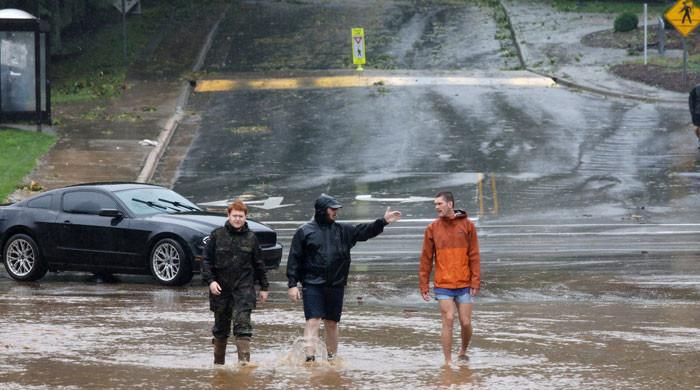ATLANTA: Tropical Storm Helene caused life-threatening flooding in the Carolinas on Friday after leaving widespread destruction as a major hurricane in Florida and Georgia overnight that killed at least 33 people, flooded neighborhoods and left more than 4 million homeless. homes and businesses without electricity.
Helene hit the Big Bend region of Florida as a powerful Category 4 hurricane on Thursday at 11:10 pm ET (0310 GMT Friday) and left a chaotic landscape of overturned boats in harbors, downed trees, submerged cars and flooded streets. .
Police and firefighters carried out thousands of water rescues in all affected states, including Atlanta, where an apartment complex had to be evacuated due to flooding.
Helene made landfall in Florida with winds of 140 mph (225 kph), weakening to a tropical storm as it moved toward Georgia on Friday morning. By early afternoon, the storm had been downgraded to a tropical depression and had maximum sustained winds of 35 mph (55 kph) as it slowed over Tennessee and Kentucky, the National Hurricane Center said.
Helene's heavy rains continued to produce catastrophic flooding in the southern Appalachians, the NHC said.
More than 50 people were trapped on the roof of a hospital midday Friday in Unicoi County, Tennessee, about 120 miles northeast of Knoxville, local media reported, as floodwaters inundated the rural community.
Rising waters of the Nolichucky River were preventing ambulances and emergency vehicles from evacuating patients and others there, the Unicoi County Emergency Management Agency said on social media, but emergency crews on boats were carrying out rescues.
In western North Carolina, Rutherford County emergency officials warned residents near the Lake Lure Dam just before noon to immediately evacuate to higher ground, saying “dam failure is imminent.”
In nearby Buncombe County, mudslides forced the closure of Interstates 40 and 26, the county said on X-Day.
The extent of the damage in Florida began to become known after dawn.
Off the coast of Steinhatchee, a storm surge (the wall of seawater pushed ashore by winds) of eight to 10 feet (2.4 to 3 meters) displaced mobile homes, the NWS said in X. In Treasure Island, a barrier island community in Pinellas County, boats were stranded in front yards.
The city of Tampa posted on X that emergency personnel had completed 78 water rescues of residents and that many roads were impassable due to flooding. The Pasco County Sheriff's Office rescued more than 65 people overnight.
The US Coast Guard said it had saved nine people from stormy waters. A video posted online showed a Coast Guard crew pulling a man and his dog in life jackets out of the ocean Thursday after their sailboat became disabled off Sanibel Island.
Kevin Guthrie, Florida's emergency management director, urged residents in affected areas to stay off the roads.
“I'm begging you, don't come out,” Guthrie said at a morning news conference. “We have 1,500 search and rescue personnel in the impacted areas. Please move out of the way so we can do our job.”
Authorities had pleaded with residents along Helene Road to heed evacuation orders, describing the storm surge as “insurmountable,” as NHC Director Michael Brennan warned.
In Taylor County, the Sheriff's Department wrote on social media that residents who decided not to evacuate should write their names and dates of birth on their arms in permanent ink “so they can be identified and their family members notified.”
Some residents had stubbornly stayed put.
Ken Wood, 58, a state ferry operator in Pinellas County, said he should have followed evacuation orders instead of riding out the storm at home with his 16-year-old cat Andy.
“I'll never do that again, I swear,” Wood said. “It was a heartbreaking experience. It roared all night like a train. It was disconcerting. The house shook.”
Down the hill from his house, the storm flooded some houses with chest-deep salt water. A house caught fire and burned, sending flames 30 feet into the stormy sky, he said.
“Old Andy didn't seem to care,” Wood said. “He did well. But next time we leave.”
Some of Wood's neighbors weren't so lucky. Pinellas County Sheriff Bob Gualtieri said first responders were unable to respond to several emergency calls from residents overnight due to the conditions. On Friday, county authorities found at least five people dead.
Two more people died in Florida, Governor Ron DeSantis confirmed. Georgia Gov. Brian Kemp cited 11 storm-related deaths in his state so far, while North Carolina Gov. Roy Cooper said there had been two deaths in his state.
At least 13 people died during the storm in South Carolina, the Charleston-based Post and Courier newspaper reported, citing local officials.
Helene was unusually large for a Gulf hurricane, forecasters said, although a storm's size is not the same as its strength, which is based on its maximum sustained wind speed.
A few hours before landfall, Tropical Storm Helene's winds extended 500 kilometers (310 miles), according to the National Hurricane Center. By comparison, Idalia, another major hurricane that hit Florida's Big Bend region last year, had tropical storm-force winds that extended 160 miles (260 km) about eight hours before making landfall.
Airports in Tampa, Tallahassee and St. Petersburg suspended operations on Thursday but reopened on Friday, although long delays were expected.












